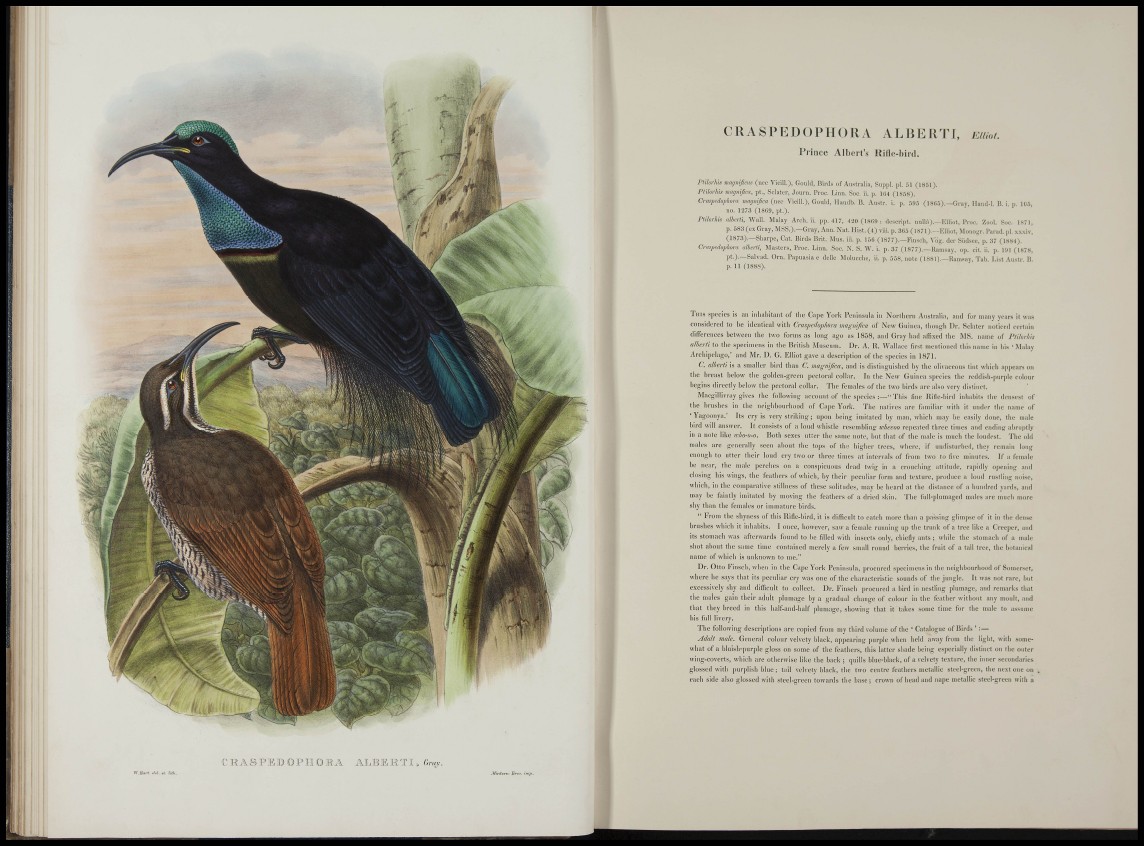
CRASPEDOPHOllA ALBERTI, icum.
Princc Albert's Hide-hird.
Ptihrhh mmjmficiis (nec Vieill.), Gould, Tiirds of Australia, Suppl. pi. 51 (1851).
PlHorhis magmfica, pt., Sclater, Journ. Proc. Liiiu. Soc. ii. p. I(i4 (ISiiS).
Craspedophora mmjuifica (nec Vieill.), Gould, Ilatidb. B. Austr. i. p. 5i>5 (ISIi.'i).—Giay, llaiul-l. 11. i. p. 105,
no. 1273 (IStil), pt.).
nHorhis alherti, Wall. Malay Arcli. ii. pp.417, .120(18«!; desci-ipt. null!!).—Elliot, I'roc. Zool. Soc. 1H71,
p. 68.1 (ex Gray, M,SS.).—Gray, Ann. Nat. Hist. (4) viii. p. 3G5 (1871).--Klliut, Monogr. I'arad. pi x.xxiv.
(1873).—Sharpe, Cat. Birds Brit. Mus. iii. p. 10(i (1877).—Finscli, \og. der Siidsee, p. 37 (1884).
Crmpedoplwm alherti, Masters, Proc. Linn. Soc. N. S. \V. i. p. 37 (1877).—Ramsay, op. cit. ii. p. 101 (1878,
pt.).—Salvad. Orn. Papuasia e delle Molucclie, ii. p. 558, note (1881 ).— Rarashy, Tab. List Austr. B.
p. 11 (188S).
T i n s spccics is an inlialiltiint of the Cape York Peninsula in Nortlicrn Australia, aiul for many years it was
considered to be identieal with Craspedophora magmfica of New Guinea, though Dr. Selater noticed certain
differences between the two forms as long ago as 1858, and Gray had affi.ved the MS. name of I'lUorhis
allerti to the specimens in the British Mnscum. Dr. A. 1!. Wallace first mentioned this name in liis 'Malay
Archipelago," and Mr. D. G. Elliot gave a description of the species in 1871.
C. alberti is a smaller bird than C. magnifica, and is distinguished by the olivaceous tint which appears on
the breast below the golden-green pectoral collar. In the New Guinea species the reddish-purplc colour
begins directly below the pectoral collar. The females of the two liirds are also very distinct.
Macgillivray gives ihe following aceoinit of the species This fine liille-bird inhabits the densest of
the brushes in the neighbourhood of Cajie York. The natives are familiar with it nniler the name of
' Yagoonya.' Its cry is very striking ; upon being imitated by man, which may be easily done, the male
bird will answer. It consists of a lond whistle resembling wheeoo repeated three times and ending alimjilly
in a note like who-o-o. Both se.ves utter the same note, but that of the male is much the loudest. The old
males are generally seen about the tops of the higher trees, where, if undisturbed, they remain long
enough to utter their loud cry two or three times at intervals of from two to five minutes. If a female
be near, the male perches on a conspicuous dead twig in a crouching altitude, ra|iidly o|)ening and
closing his wings, the feathers of which, by their peculiar form and te.vture, iirodiice a loud rustling noise,
which, in the comparative stillness of these solitudes, may be heard at the distance of a hundred yards, and
may be faintly iniilated by moving the feathers of a dried .skin. The full-plnmaged males are much more
shy than the females or immature birds.
" From the sliy ness ol this IliHe-bird, it is diliicnlt to catch more than a passing glimpse of it in the dense
brushes which it inhabits. I once, however, saw a female running up the trunk of a tree like a Creeper, and
its stomach was afterwards found to he filled with insects only, cliielly ants ; while the stomach of a male
shot iiboiit the same time contained merely a few small round berries, the fruit of a tall tree, the biitanical
name of which is unknown to me."
Dr. Otto Filiseli, when in the Cape York Peninsula, ¡irocured specimens in tlie neighbourhood of Somerset,
where he says that its peculiar cry was one of the characteristic sounds of the jungle. It was not rare, but
excessively shy and difficult to collect. Dr. Finscli |irocured a bird in nestling plumage, and remarks that
the males gain their adult plumage by a gradual change of colour in the feather without any moult, and
that they breed in this half-and-half plumage, showing that it takes some time for the male to assume
his full livery.
The following descr!|)tions are copied from my third volume of the ' Catalogue of Birds ' :—
Adult male. General colour velvety black, ajijiearing pnrjile wdien held away from the light, with somewhat
of a bluisli-pur|ile gloss on some of the feathers, this latter shade being esjiecially distinct on the outer
wing-coverts, which are otherwise like the back ; qnills blue-black, of a velvety texture, the inner secondaries
glossed with ]iur|ilish blue; tail velvety black, the two centre feathers metallic steel-green, the next one on ,
each side also glossed with steel-green towards the base; crown of head and nape metallic steel-green with a
X
/f A t .
C K A S P E B O P H O H A ALBERTI, ftmv.
IV \i»vt .M. ft lid.. JliiiJerTi- Brnr. imp.